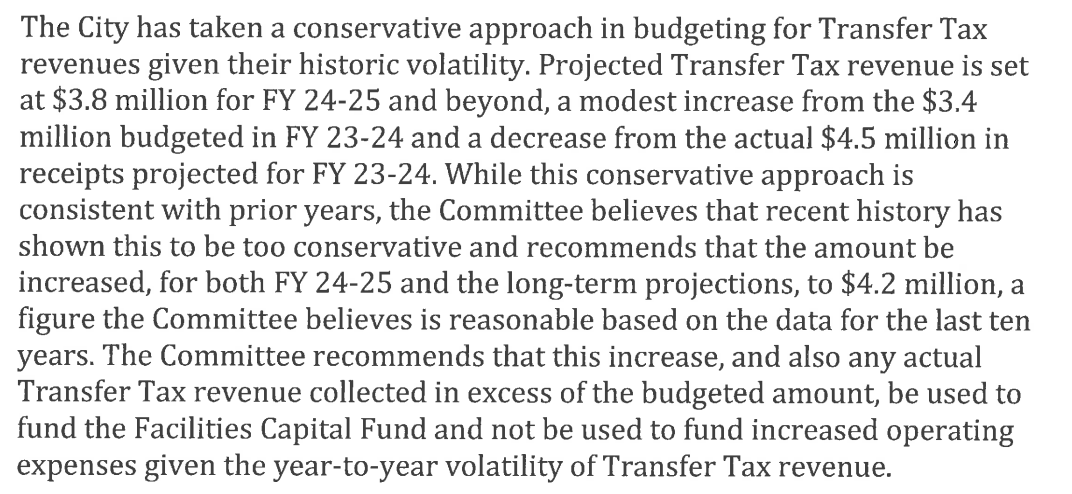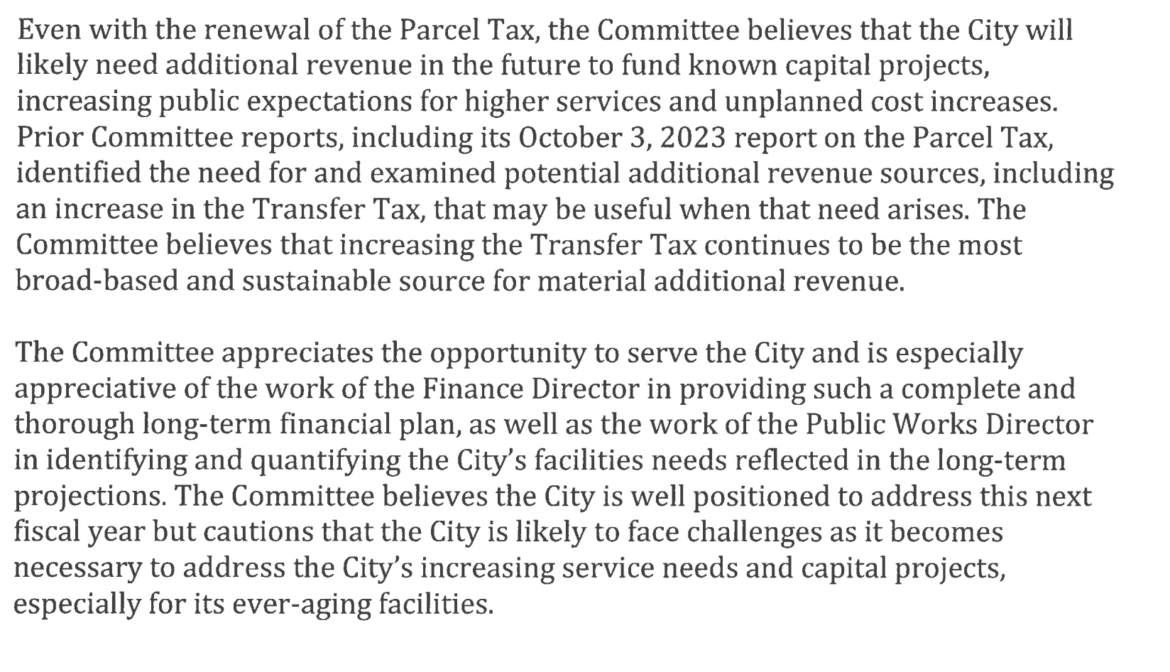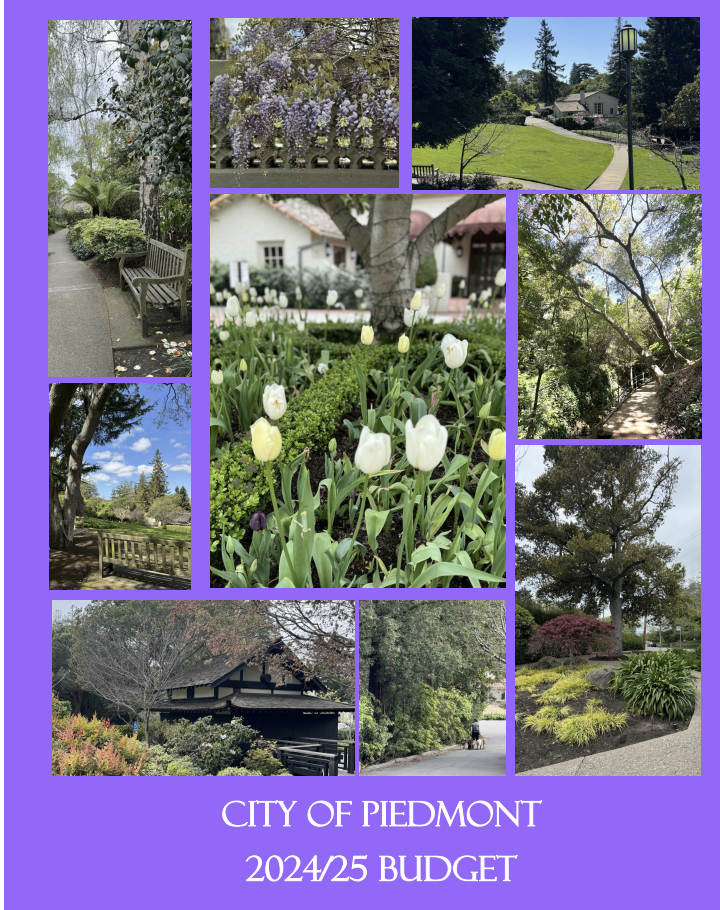The City Council held the first of two public hearings on the FY2024-2025 budget on June 3. Finance Director Michael Szczech presented the budget and Frank Ryan, the chair of the city’s budget advisory and financial planning committee, shared that group’s recommendations. (You can do a deep dive on the numbers HERE.)
A series of four City Council study sessions devoted to establishing city goals and priority projects, as well as examining revenue projections and “noteworthy budget variables”, took place in March and April. The Council identified four key efforts for FY 2024-25, according to Szczech’s report: completion of the community pool project, the dispatch center relocation project, the Sidney and Irene Dearing Memorial project, and substantial progress toward addressing a future public safety building within the Civic Center area.
From the report:
The proposed 2024-25 budget projects an operating net Income of $1.7 million in the General Fund. After capital transfers of $2.0 million (primarily ARPA funds) to the Facilities Capital Fund and $1.4 million to the Facilities Maintenance and Capital Improvements Fund, the General Fund will experience a net loss estimated at $1.7 million, which results in a projected ending General Fund Balance of $6.8 million, or 17% of operating expenditures.
Property-related taxes are the city’s primary revenue source and account for $24,617,200 or 61% of General Fund revenues. Szcech noted that although home sales rose 6% last year, the average sales price fell 7% to $2.8 million, the first year over year decline since 2010-2011.

The report highlights key factors — expenses related to implementing the Housing Element, the community pool project, and developing a master plan for Civic Center buildings — governing the current and future budgets:
Housing Element demands puts pressure on city staff
The 6th Cycle Piedmont Housing Element for 2023 to 2031 continues to represent a significant investment of City time and resources. To date, hundreds of community members have participated by attending public meetings, community workshops, completing surveys, submitting comment letters, and using online planning tools. This investment in a thoughtful, inclusive, and open planning process has produced Piedmont’s housing plan, which the city is now implementing. Thoughtful planning has positioned the City to transform growth into a benefit for the community as a whole. Significant efforts were initiated beginning in FY 2021-22 and this process will continue through FY 2024-25.
Unforeseen costs and inflation adding to pool costs
Development of the city’s newest facility is in progress. In November 2020, voters approved the sale of up to $19.5 million of bonds to be used in the construction of a new community pool and related facilities. In December 2021, after obtaining a Standard & Poor’s “AAA” rating, the city successfully sold $19.5 million in general obligation bonds at very favorable interest rates, netting the city $24.4 million in available project funds. Due to rapid inflation in construction costs, the total all-in project budget, including the pools, building, offsite right of way improvements, full facility electrification, and two bid additives (Scoreboard/Timing System and Upgraded Lighting) is estimated to be $28.9 million. An increase of $1.0 million, bringing the total overall budget to $29.9 million, was approved by the City Council in December 2023.
The increase was due to unforeseen costs to remove two buried fuel tanks along with the contaminated soil, as well as construction delays due to weather and PG&E. The pool is now targeted to open in early 2025.
Expenditures beyond the initial $24.4 million raised in the bond offering will be primarily funded by major private donors, the Piedmont Recreational Facilities Organization (PRFO) fundraising campaign, support from the Kroeger estate and the California Energy Design Assistance Program, an AVA Community Energy loan associated with the electrification of the pool, and internal capital funds.
Master plan needed to address aging public safety buildings
Interest in the future of our aged facilities is also on the horizon. The city has reached a point of critical mass with the deficiencies identified in Piedmont’s essential services buildings that house public safety. In FY 2023-24, an ad hoc subcommittee of the City Council revisited prior work performed to date and led discussion of the topic with the entire governing body. Unanimous consensus included direction to prioritize a master planning framework and develop an actionable series of next steps. Staff is including $600,000 in the FY 2024-25 Capital Budget to develop a phased plan for the Civic Center area that prioritizes future address of the city’s public safety facilities.
Budget advisory group says there’s not enough money to cover city’s infrastructure needs
Ryan said the committee recommends increasing the transfer tax to help fund the Facilities Capital Fund.

In its final assessment, the budget advisory group cautioned that funding increasing service needs and aging infrastructure projects will be a challenge going forward:

The final public hearing on the proposed budget will be on Monday, June 17 at which time the council is expected to approve the budget.

The BAFPC consistently underestimates revenues because it uses a rolling average of the past 10 years of transfer tax revenue to predict revenue for the next 10 years. This lagging approach inevitably leads the committee to conclude that tax increases are needed. When a standard forecasting method is used (https://piedmontexedra.com/2024/02/letter-to-the-editor-whats-the-rush-to-pass-measure-f) $10M more than the BAFPC projection is realized. This approach takes into account volatility that the committee is rightly concerned about. The BAFPC really should provide both projections to Council before proposing new taxes.